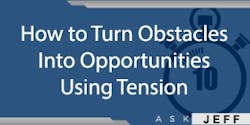Mike, maintenance manager, GA
Answer: Hello, Mike. Recently, I was talking with a group of site leaders as part of a series of coaching visits to help the leaders improve reliability and reduce the costs they faced. One of the leaders smiled and commented that I thrive on controversy. This comment came on the heels of a meeting in which one of the team members had shared honest feedback. I smiled back and said, "It’s not controversy; it’s tension to encourage people to improve their situation by moving out of their comfort zone."
Peter Senge, the author of The Fifth Discipline, described the concept of creative tension in his book. Creative tension provides a structure to facilitate change. Simply put, creative tension is created when an organization’s vision is articulated and compared against the apparent current state. The gap between the two states establishes a pressure that is both emotional and energetic.
Consider two hands, one placed higher than the other. The upper hand reflects the desired state. The lower hand represents the status quo. A rubber band encircles both hands. As the distance between the hands increases, so does the tension on the rubber band. The rubber band tries to pull back to its relaxed state with force proportional to the stretched distance.
When I apply reliability coaching within organizations, my objective is to create enough tension to lift the organization toward the desired state using a step-by-step approach. Too much pressure as a product of overly aggressive goals can lead the rubber band to snap, creating a free-fall back into the comfort zone. To relieve some tension, define milestones that will prevent a loss of focus on the vision. Once you get the organization rising out ot its current state, it’s critical to maintain consistent tension that will drive continued improvement. Too little tension will make it easy for people to drift back down to the status quo. Having tension also provides a sense of urgency that I find many organizations lack.
There are two initial focus areas to consider for reducing reactive chaos. One is your organization's PM/PdM program so that you are eliminating, preventing, reducing, or mitigating the consequences of failure. Simply put, we must do the right work at the right time in the right way. The second area is effective planning and scheduling. Having a schedule for the week that utilizes all available labor sets an expectation of work to be accomplished. Planning focuses on determining the job duration and task steps and obtaining the required materials to eliminate avoidable delays.
We must have some level of auditing and measure our performance to understand whether we are transitioning from the current state toward the intended goal. Realize that "lead" and "lag" occurs in goals just as it does in metrics. Goals such as increased revenue or market share won't be effective leading motivators at the plant-floor level. A goal must be actionable and meaningful at the plant-floor level.
Begin by understanding the current state. In some cases, that may require an assessment to help understand the gap. Articulate the vision of the desired state and then educate people. I find that many organizations fail to provide guidance not only about the goal but also about the path to achieving it. For some, vision alone stimulates desire, but often, that doesn’t get the job done. Once people understand, move beyond talk and set expectations using a step-by-step approach. Create the tension. Measure the results. Adjust the tension to ensure the organization continues to climb toward its goals. The process becomes a loop: Deming’s plan-do-check-act loop.
What insights would you add? Please share your feedback.
Send me an email at the address below, and I will respond or place your questions with my answers here.
Talk soon,
Jeff Shiver, CMRP
If you have problems in the fields of maintenance, reliability, planning and scheduling, MRO storerooms, or leadership, please contact Jeff Shiver with your question(s) here.
About the Author
Jeff Shiver
Founder and managing principal at People and Processes, Inc.
Jeff Shiver CMRP is a founder and managing principal at People and Processes, Inc. Jeff guides people to achieve success in maintenance and reliability practices using common sense approaches. Visit his website www.PeopleandProcesses.com, and contact him on LinkedIn at www.linkedin.com/in/jeffshiver or via email at [email protected].


